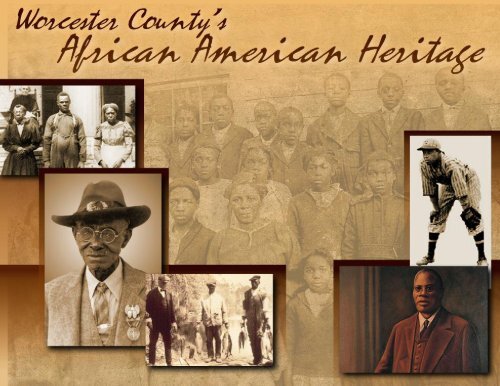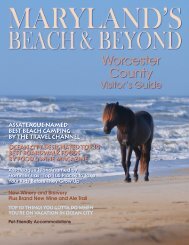African American Heritage - Worcester County Tourism
African American Heritage - Worcester County Tourism
African American Heritage - Worcester County Tourism
- No tags were found...
You also want an ePaper? Increase the reach of your titles
YUMPU automatically turns print PDFs into web optimized ePapers that Google loves.
By the mid 19th century, John Upshur Dennis owned 160 slaves who worked hisnumerous properties. Historically, <strong>Worcester</strong> <strong>County</strong> had a large number of slaveholdingplanters who erected an assortment of dwellings to house their slaves. TheMerrill farm slave house, erected of hewn logs enclosing a single room, is one of thefew examples of slave housing that has survived to modern times.Find out more:Influence of Prominent Abolitionistshttp://lcweb.loc.gov/exhibits/african/afam006.html (Library of Congress)The Internet <strong>African</strong>-<strong>American</strong> History Challengehttp://www.brightmoments.com/blackhistory/Little-known Facts About Slaveryhttp://www.theblackmarket.com/slavefaq.htmSlavery, Freedom and the Chesapeakehttp://www.mdsg.umd.edu/MarineNotes/Mar-Apr98/side1/Black Men, Blue Waters: <strong>African</strong> <strong>American</strong>s on the Chesapeakehttp://www.mdsg.umd.edu/MarineNotes/Mar-Apr98/index.phpMaryland in the Civil War: The 1st MD Eastern Shore Regimenthttp://www.globalclassroom.org/mdinvlv.html (Global Classroom)The Autobiography of Frederick Douglasshttp://odur.let.rug.nl/~usa/B/fdouglas/dougxx.htmThe Emancipation Proclamationhttp://www.nps.gov/ncro/anti/emancipation.htmlUnderground Railroadhttp://www.nps.gov/undergroundrr/contents.htmMerrill Farm Slave HousePocomoke City vicinity5
Feel The Spirit: Churches<strong>Worcester</strong> <strong>County</strong> has a strong history of resistance to slavery. Common to manyplaces on the Eastern Shore, there are numerous claims by <strong>Worcester</strong> <strong>County</strong>homeowners as to their property being used as a stop along the "UndergroundRailroad." Several of the white churches, whether of Methodist, Episcopal, Baptist orPresbyterian faith, provided a slave gallery for a segregated worship service. Thegallery at Beaver Dam Presbyterian Church south of the Pocomoke City and the galleryin St. Martin's Church have strong oral traditions as seating for <strong>African</strong>-<strong>American</strong>s.Germantown, located east of Berlin, is the siteof the New Bethel Methodist Church,distinguished as one of the oldest <strong>African</strong>-<strong>American</strong> congregations. Tracing itsorganization back to 1855 by a group of freefamilies, the New Bethel Methodists wereformerly members of the Stevenson MethodistEpiscopal Church in Berlin.St. Paul's Church, Berlin With a strong presence of Methodist anti-slaveryteachings in the area by the late 18th century,and the nearby location of the abolitionistleaders in northern Delaware and Philadelphia, fugitive slaves made their way norththrough this region from the lower Eastern Shore counties of Maryland and Virginia. Thedense and natural cover provided by the Pocomoke River and its tributaries, stretchingwell into Sussex <strong>County</strong>, surely aided numerous slaves in their clandestine journey northto refuge in Wilmington, Delaware and Philadelphia.A principal focus for each <strong>African</strong>-<strong>American</strong> community was the organization andconstruction of a church. Due to Methodism's strong stance against slavery, the newlyformed congregations were largely of the Methodist faith, but a few Baptist groups wereestablished as well. The churches built to house these new congregations were erected inthe Gothic Revival style, which was widely popular during the second half of the 19thcentury.St. Martin's Methodist Church,ShowellEbenezer UnitedMethodist Church, Snow Hill6
Didn't It Rain: Civil WarWith its closeness to Virginia, the lower Eastern Shore population was bitterly divided on issues surrounding the Civil War. Formost Southern sympathizers on the lower Shore, the federal recruitment of free blacks and fugitive slaves was an intolerableinsult. It is estimated that 20 percent of Maryland's Union companies were composed of black soldiers.General Lockwood, commander of the Eastern Shore companies, was especially activein recruiting black enlistees. One Civil War participant from <strong>Worcester</strong> <strong>County</strong>, Isaiah"Uncle Zear" Fassett (1844-1946) was born into slavery southeast of here in Sinepuxentin 1844. His owner, Sarah A. Bruff, released him from bondage at age nineteen onNovember 11, 1863, when the U.S. Army paid her $300 in compensation. That sameday, Fassett enlisted in Company D, 9th United States Colored Troops.This infantry regiment served in South Carolina and also fought in several battles inVirginia in 1864.1865, including the Wilderness, Deep Bottom, Fussell's Mill, Fort Gilmerat Chaffin's Farm, and the siege of Petersburg. The regiment was among the first tooccupy Richmond on April 3, 1865. After the Confederate capital fell, Fassett waspromoted to corporal then discharged on November 26, 1866. His brothers, Franklin,Andrew, John, and George, also were freed and served in the U.S. Army.Isaiah Fassett settled in Berlin after the war. Known in his later years as Uncle Zear, hewas among Maryland's "Boys of '61" who attended the 75th reunion at Gettysburg in July1938. Fassett served as commander of the Grand Army of the Republic post in Berlinuntil it disbanded, then was GAR department commander in Delaware from 1943 until hisdeath. He was Maryland’s next-to-last surviving Civil War soldier when he died on June24, 1946.Isaiah Fassett(Photo courtesy David Briddell)Memorabilia associated with Isaiah Fassett and other <strong>African</strong> <strong>American</strong> Civil War soldiersare in the collections of the Calvin B.Taylor House Museum here in Berlin, Maryland. Like many other Eastern Shore counties,<strong>Worcester</strong> <strong>County</strong> was ahaven for spies and smugglers because it was home to many Confederate sympathizers and because of its proximity to thePocomoke River and the Chesapeake Bay. One such smuggler, Dr. Isaac Costen, made many clandestine trips by sailingdown the Pocomoke River, hugging the coastline to Exmore, Virginia and crossing the bay into the Rappahannock River.8
Following the Civil War, <strong>Worcester</strong> <strong>County</strong> black residents turned to livelihoods they hadknown before the war, sometimes hiring on as sharecroppers for their former masters.One of the beloved 19th century black figures of <strong>Worcester</strong> <strong>County</strong> was Sampson Harmon,fictionalized as "Sampson Hat" in George Alfred Townsend's novel, "The Entailed Hat."Portrayed as a folk hero, he was reputed to be the strongest and fastest man in at least twocounties and able to run down a deer to capture it. He is best remembered as a long-timeresident of Furnace Town, where he worked for Judge Thomas Spence who operated thefurnace during the mid 19thcentury. Sampson Harmonreached 106 years of age.<strong>Worcester</strong> <strong>County</strong> Courthouse, ca. 1861.The courthouse, jail, and adjacent buildings were erectedafter a fire that burned the center of the county seat in 1834.(Image courtesy <strong>Worcester</strong> <strong>County</strong> Commissioners)From Maryland Civil WarTrails: Staging Ground at the<strong>Worcester</strong> <strong>County</strong>Courthouse:Sampson Harmon(Photo courtesyJulia A. Purnell Museum)In November 1861, a force ofabout 4,500 United StatesArmy officers, soldiers, cavalrymen, and artillerists assembledin and around Snow Hill. Some of the troops camped here onthe <strong>Worcester</strong> <strong>County</strong> Courthouse yard. Gen. Henry H.Lockwood commanded the expedition, which marched souththrough the Eastern Shore to Accomack and NorthamptonCounties in Virginia via the Pocomoke River as a show of Unionstrength on the Eastern Shore. Lockwood’s orders were toreassure the civilian population, restore lighthouses to workingorder, and to disarm and disperse any Confederates that hiscommand encountered.9
When Lockwood began marching south on November 14, his force included adiverse collection of units, including detachments of the 4th and 14th WisconsinInfantry, 2nd Indiana Infantry, 1st Michigan Infantry, 2nd Delaware Infantry, 1stEastern Shore Maryland Home Guard, Capt. Ormand F. Nims’s Boston Battery(six brass rifled field pieces), Capt. Thomas S. Richards's Company ofIndependent Cavalry (later Co. M, 1st Pennsylvania Cavalry), Col. William H.Purnell’s Legion, and 500 of Duryee's Zouaves (Col. Abram Duryée's 5th NewYork Infantry).The expedition followed the Pocomoke River to Newtown (present-day PocomokeCity) and then marched overland to Drummondtown in Virginia. Lockwoodencountered small numbers of Confederate troops and rudimentary defenses atNewtown and also in Virginia at Temperanceville and Drummondtown. TheConfederates fled, and many of them threw their weapons aside as they escaped.Lockwood, along with his family, occupied the Drummondtown house of Dr. PeterF. Brown, who had fled across the Chesapeake Bay. The expedition wasconsidered successful and ended on November 22.Gen. Henry H. Lockwood(Photo courtesy Library of Congress)Find out more:The Black Military Experience in the Civil Warhttp://www.history.umd.edu/Freedmen/bmepg.htmHistory of <strong>African</strong> <strong>American</strong>s in the Civil War National Park Servicehttp://www.itd.nps.gov/cwss/history/aa_history.htmPurnell Legion Cavalry, UShttp://www.2ndmdinfantryus.org/uscavPLC.html10
Go Down Moses: Free BlacksEmerging as a new and significant part of the <strong>Worcester</strong> <strong>County</strong> populace during thefirst half of the 19th century were free blacks. Numbering only 446 in 1800, thepopulation of free blacks had expanded to 3,500 by 1860.While a few of the free blacks living in <strong>Worcester</strong> <strong>County</strong> in 1800 could trace theirancestry back to free black colonists, the larger part descended from ex-slaves whohad been freed following the Revolution. Despite the overwhelming odds againstthem, a few of these former slaves were able to establish remarkable estates duringthe first half of the 19th century.As tensions surrounding the issue of slavery escalated during the 1840s and 1850s,free blacks were viewed with suspicion as natural allies of the remaining slavepopulation. As a result, the decades before the Civil War found free blacks across<strong>Worcester</strong> <strong>County</strong> segregating themselves in distinct communities with the obvioushope that strength in numbers would offer some measure of protection. The blackneighborhood of the southwest side of Snow Hill is historically identified as"Freetown" and several dwellings, including the Harmon House, date before the CivilWar.A ship similar to the Liberia PacketAs the Civil War drew near the numbers of manumitted or freed slaves grew significantly in <strong>Worcester</strong> <strong>County</strong>. Several ofthese former slaves, as well as some free blacks, left <strong>Worcester</strong> <strong>County</strong>. Several of these former slaves, as well as some freeblacks, left <strong>Worcester</strong> <strong>County</strong> in an effort to escape the hostilities common before the war.Several families residing near Snow Hill around 1830 relocated to a watermens' community known as Sandy Ground on NewYork's Staten Island, Members of the Hinman, Lambden, Bishop, Purnell, Robins and Johnson families established newhomes along the island's south coast, engaging primarily in the oyster business they had known on the Eastern Shore.Other Snow Hill blacks are credited with establishing the town of Snow Hill, New Jersey, later changed to Lawnside in 1907.11
Some went even farther leaving the United States altogether. Dozens of freeblacks or former slaves embarked on a return to Africa through the office of theMaryland Colonization Society. Members of the Bowen, Fooks, Johnson andDennis families can trace ancestors who made the voyage across the Atlantic.Judge Ara Spence, owner of the Mansion House at Public Landing, left aspecific clause in his will for his slaves, where were to be freed and transportedto Liberia following his death.Find out more:Man with Ox Cart(Photo courtesy of Fred Bruekmann)Map of Maryland <strong>County</strong>, Liberia (Library of Congress)http://rs6.loc.gov/cgi-bin/query/r?ammem/gmd:@FILREQ(@field(SUBJ+@band(Liberia--Maryland+<strong>County</strong>.+))+@FIELD(COLLID+lmmap))<strong>African</strong>-<strong>American</strong> Mosaic: Colonization (Library of Congress)http://lcweb.loc.gov/exhibits/african/afam002.htmlEmigration Back to Africa Movementhttp://www.theblackmarket.com/slavefaq.htm#Emigration Back to Africa MovementEx-Slave Narratives (Library of Congress)http://lcweb.loc.gov/exhibits/african/afam015.html To Be More Than Equal: The Many Lives of Martin R. Delany (1812-1885)http://www.wvu.edu/~library/delany/home.htmMapping Africa: Africa and the Diaspora Movementhttp://artsedge.kennedy-center.org/aoi/images/diasp2.jpgThe Great Migrationhttp://artsedge.kennedy-center.org/educators/lessons/grade-3-4/Great_Migration.aspx12
March On: SoldiersThe 20th century brought much hope, but many difficulties remained for <strong>African</strong>-<strong>American</strong>s onthe Eastern Shore with continued segregation and outbreaks of racism. As in wars past, localblack residents served bravely in World War I, World War II, as well as the Korean and Vietnamconflicts.Continuing a tradition established after the Civil War were the Buffalo soldiers who started out asmembers of the all-black 10th Cavalry Regiment sent west to keep peace between native<strong>American</strong>s, white soldiers, and settlers. In a segregated armed forces, the 10th Calvary's "Buffalosoldiers" served later with Teddy Roosevelt when he and his "Rough Riders" stormed San JuanHill during the Spanish-<strong>American</strong> War in 1898, and even afterwards, during World Wars I and IIas well as Korea.One of the last of a group of enlistees to serve as a Buffalo soldier was <strong>Worcester</strong> <strong>County</strong> native,Edward Johnson, who was born in Snow Hill on December 2, 1918. He enlisted in the 10thCalvary Unit in 1939 just prior to turning 21. Trooper Edward Johnson served in the United StatesArmed Forces for over 31 years, retiring as a Sergeant Major in 1971.Edward Johnson, Sr.One of the hundreds who served in the United States AirForce was Lieutenant Colonel Edward P. Drummond, Jr.Born in the <strong>African</strong>-<strong>American</strong> community of Unionville, west of Pocomoke City, he laterentered the last class of pilots to train at the Tuskegee Army Air Field in Alabama. Hewent on to dedicate 25 years of his adult life to the United States Air Force, retiring in1970. Lieutenant Colonel Edward P. Drummond, Jr. Amassed over 6000 flying hoursduring the Korean and Vietnam conflicts, and he was highly decorated for that service.Lt. Col. Edward P. Drummond, Jr.Find out more:Buffalo Soldiers & The Indian Warshttp://www.buffalosoldier.net/History and Roster of Maryland Volunteers - U.S. Colored Troopshttp://aomol.net/000001/000366/html/index.html13
Hold Your Light: SegregationSchools and other public institutions were once segregated like much of the rest of thecountry until the 1960's. Ocean City was strictly segregated as well during the early20th century. Reserved periods, known as "Colored Excursion Days," were limited todays after the principal summer season.Formerly known as "Henry's Colored Hotel," the prominent three-story shingled framestructure survives as one of the oldest hotels in Ocean City today. Charles T. and LouisHenry bought the hotel in December 1926.Duke Ellington, Cab Calloway, Count Basie and Louis Armstrong were guests ofHenry's Hotel in the days when black entertainers could perform in major hotelballrooms, yet not sleep in the hotels themselves.The Henry Hotel, Ocean CityAnother site in Pocomoke City, Mar-Va Theater, has an interesting <strong>African</strong>-<strong>American</strong> association with its segregated entranceand seating used solely by blacks. Little changed since it was redecorated in 1937, the interior of the Mar-Va has a separatestaircase, ticket booth, bathroom, concession stand and seating in the balcony that were intended for black visitors.Mar-Va TheaterOutten's Colored Theater, Snow HillCharles Henry14
Segregation also played a role in the national and local expression of the country's principalpastime, baseball. One of the most recognized of the national Negro League is William Julius"Judy" Johnson who was born in the vicinity of Snow Hill near Newark on October 26, 1899.He began his twenty-one-year Negro League baseball career in 1918, and he participated inmore than 3,000 professional games, earning recognition from his peers as the best all-timethird baseman. In 1975, "Judy" Johnson was inducted into the National Baseball Hall of Famein Cooperstown, New York. Memorabilia on "Judy" Johnson are on display at the Julia A.Purnell Museum in Snow Hill.Local baseball teams were segregated as well, as represented by the Legionnaire Stars teamof Pocomoke City. Formed in 1945 following WWII, the team was composed of former warveterans and graduates of the Stephen Long School and <strong>Worcester</strong> High School. The teamplayed up and down the Eastern Shores of Maryland and Virginia over a three-year period.The community aided the team in the purchase of supplies. Similar teams played in other partsof <strong>Worcester</strong> <strong>County</strong> and those teams included the Berlin Eagles, Snow Hill's Hanks, theShowell Wildcats and the Stockton Braves. Some of these teams continued to play as late asthe early 1970s.Judy JohnsonCooperstown BaseballHall of FameFind out more:From Segregation to Integration: The Donald Gaines Murray Case, 1935-37 (Maryland Archives)http://www.mdarchives.state.md.us/msa/stagser/s1259/121/1844/html/0000.htmlNegro Baseball League Sitehttp://www.blackbaseball.comWith Little Deliberate Speed: School Integration in Prince George's <strong>County</strong>, Marylandhttp://odur.let.rug.nl/~usa/E/integration/integrx.htmThurgood Marshall Biographyhttp://www.npg.si.edu/exh/harmon/marsharm.htmThe National Women's Hall of Fame: Rosa Parkshttp://www.greatwomen.org/women-of-the-hall/search-the-hall/details/2/116-ParksThe Movies, Race and Ethnicity: <strong>African</strong> <strong>American</strong>s (Media Resources, UC Berkley)http://www.lib.berkeley.edu/MRC/imagesafam.html<strong>African</strong>-<strong>American</strong> Odyssey (Library of Congress)http://lcweb2.loc.gov/ammem/aaohtml/aohome.html15
I'm On My Way: EducationThe Sturgis One Room School Museum was restored and openedin downtown Pocomoke City in May 2000.Earlier in this century,local <strong>African</strong>-<strong>American</strong> families raised their children within thesegregated educational system established throughout the state.Representative of the dozens of facilities used by black children isthe Sturgis One-Room School. (Opened as a museum in 2000 it iscurrently located on Willow Street in downtown Pocomoke City.)Dating around 1900, the weatherboard frame structure was usedfor elementary grades until the Stephen Long School in PocomokeCity opened in 1937. The school has been restored and welcomesvisitors on Wednesdays and Saturdays from 1 -4 pm, May -October, and by appointment.The Sturgis One Room SchoolClass at Sturgis SchoolWillie Sturgis16
Higher education was segregated as well. Founded in 1886 under the auspices of theDelaware Conference of the Methodist Episcopal Church and the Centenary Biblical Institute ofBaltimore, the University of Maryland Eastern Shore in Princess Anne was started as a blackoriented school of higher learning. Shortly after its inception, the Princess Anne Academy, as itwas popularly known, was designated as part of the state land-grant educational system inorder to comply with a federal mandate to offer college level education to black students. Theinstitution continued as a private school until 1926, when the State of Maryland purchased theproperty outright. It was not until 1970, however, that it became a bona fide branch of theUniversity system and named the University of Maryland Eastern Shore.Stephen Handy Long(Photo courtesy Alonzo Tull)A sound and solid education of elementary and higher learning for all black children was one ofthe principal missions advanced by local educator Stephen Handy Long (1865-1921). Born inPocomoke City at the end of the Civil War, Stephen Long grew up in Boston, Massachusetts.Stephen Long returned to the lower Eastern Shore and began his teaching career in Somerset<strong>County</strong>. He eventually became the principal of the Pocomoke Grammar School on Bank andFifth Streets.In 1914 he became the first <strong>African</strong>-<strong>American</strong> school supervisor in <strong>Worcester</strong> <strong>County</strong>. Long initiated severalmodel programs for black youth. Tragically, he was murdered onSeptember 13, 1921, in a conflict surrounding his desire to ensure thatorphan boys used as farm laborers received the education to which theywere entitled. He is buried in the Hall's Hill Cemetery. A serviceorganization, the Stephen H. Long Guild, Inc., was formed in 1980 toprovide financial assistance for the education of <strong>African</strong>-<strong>American</strong>youngsters.Find out more: Host Our Coast Video: Sturgis One Room School HouseMt. Zion One Room School17




